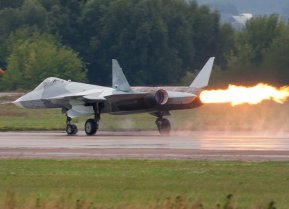Su-57 Felon: Russia's Failed Stealth Fighter
Before the Su-57 Felon, Russia had relied heavily on aging Cold War-era platforms like the Su-27 and MiG-29. However, the warplane has been built in very limited numbers.
For many years, the U.S. retained air superiority over its adversaries. The F-22 Raptor became the first fifth-generation fighter jet to take to the skies, and the F-35 Lightening II followed closely behind. To counter America’s aerial supremacy, both Beijing and Moscow poured resources into their respective air forces. Ultimately, both countries introduced their fifth-generation prototypes. The Chinese J-20 Chengdu and the Russian Su-57 platforms are designed to go up against America’s arsenal.
While both fighters have been touted by their governments to feature top-of-the-line capabilities, their exact specs and functions remain unknown.
A brief overview of the Su-57 Felon
The Kremlin has long touted that its Su-57 fighter is the most advanced fifth-generation platform of its kind.
The twin-engine stealth multirole fighter, designated by NATO as “Felon,” is the first Russian airframe in its military designed with stealth technology.
Prior to the Su-57 Felon, Russia had relied heavily on aging Cold War-era platforms like the Su-27 and MiG-29.
In the early 1980s, the Soviet Union crafted the I-90 next-generation fighter program. Initially, two subsequent projects were created to meet the government’s multirole fighter requirements. However, one was slashed due to budget constraints a few years later.
In 1991, Russia’s Ministry of Defense drafted the PAK FA program, specifically geared toward developing a replacement airframe for the Su-27 and MiG-29.
Ultimately, manufacturer Sukhoi was awarded the winner of the PAK FA competition and research/development began quickly thereafter.
Su-57 Capabilities
As Moscow’s first-ever operation stealth fighter, the Su-57 is theoretically equipped with supermaneuvrability, 3D thrust vectoring controls, and extensive internal payloads for multirole versatility.
In terms of avionics, the Felon reportedly has it all. According to Air Force Technology, this fighter is designed with the most sophisticated onboard radio-electronic equipment. Its onboard avionics systems include active electronically scanned array (AESA) radar and ELINT systems.
Another critical asset the Felon is equipped with is its advanced sensor suite and communications datalinks. These even parallel the F-22 Raptor’s and F-35 Joint Strike Fighter’s electronic intelligence.
Do the Su-57’s purported capabilities map out in reality?
Ordnance-wise, the Su-57 can pack a punch. In addition to air-to-surface missiles, the fighter carried air-to-air missiles for long-range combat.
The jet is also armed with 30mm air guns for close combat operations.
The Felon is designed with two side bays and two internal weapons bays mounted between the engines. This extra weapons storage allows for increased means to carry advanced weapons. Since these weapons are stored internally, the airframe can also fly with a lower radar profile as drag is minimized.
According to available specs surrounding the Felon, the jet is capable of traveling at speeds reaching Mach 2.0 (times the speed of sound) at ranges of roughly 2,200 miles. While these figures are impressive, the F-22 is faster.
Additionally, the Felon is not as competitive in terms of its thrust-to-weight ratio as the Raptor, either.

Su-57: The Numbers Problem
Perhaps the biggest issue the Su-57 program faces is numbers.
As explained by analyst Kris Osborn, “Regardless of the extent to which the Su-57 can truly rival U.S. 5th-generation aircraft, Russia’s next-generation aircraft primarily suffers from a numbers problem. There are just not that many of them, as multiple public reports say there are currently somewhere between four and 15 operational Su-57 aircraft, and Russia’s TASS news agency has reported plans for the country to acquire 76 Su-57s over the next five years.”
Felons have been absent in Ukraine
Russia’s low stockpile of Su-57s may be the reason this airframe has not been deployed as heavily as expected in Ukraine.
Since February 2022, Russian forces have flown a litany of platforms over Kyiv to aid the country’s offensive efforts.
The Felon, however, has been notably missing from these aerial campaigns. Some industry experts predict that Putin’s resistance to deploying this airframe in combat may also suggest that the Kremlin is not as confident in the Felon’s purported abilities.

Last summer, Britain’s Defense Ministry reported that Russia’s air force had “almost certainly used” the Felon to carry out some missions in Ukraine. The intelligence update added that “these missions have likely been limited to flying over Russian territory, launching long-range air-to-surface or air-to-air missiles into Ukraine.” If true, these missions were carried out quite sparingly and the platform has had limited if not any access to Ukrainian airspace.
Even if Moscow figures out how to produce additional Felons over the next few months, the Felon would likely not play a role in significant operations over Ukraine.
Considering the dismal performance of Moscow’s other weapon systems during its invasion, the downing of one of its “top-of-the-line” fifth-generation fighters would be quite the blow to the Kremlin’s propaganda machine.
Maya Carlin is an analyst with the Center for Security Policy and a former Anna Sobol Levy Fellow at IDC Herzliya in Israel. She has by-lines in many publications, including The National Interest, Jerusalem Post, and Times of Israel. You can follow her on Twitter: @MayaCarlin.
Image Credit: All Images are Creative Commons.


